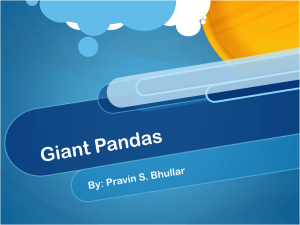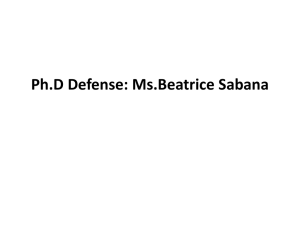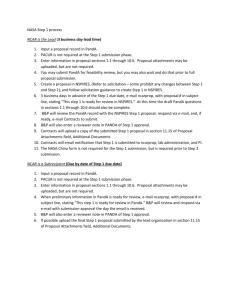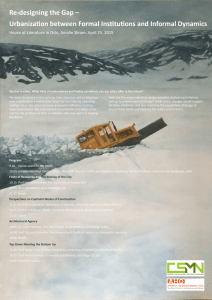- e-Lis
advertisement
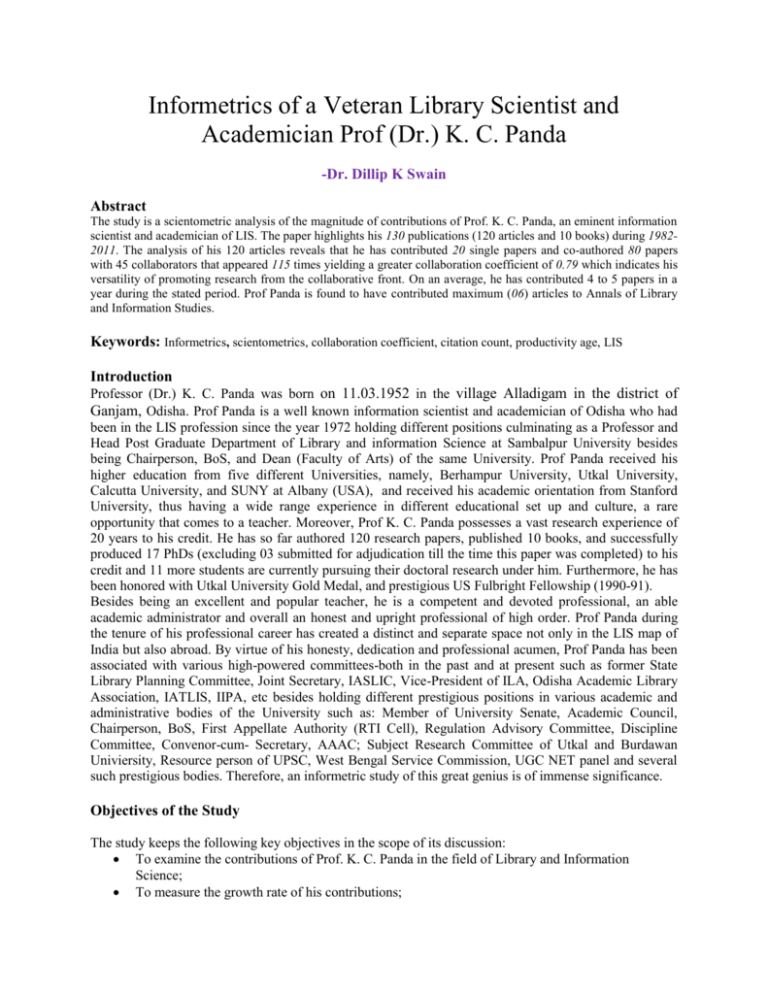
Informetrics of a Veteran Library Scientist and Academician Prof (Dr.) K. C. Panda -Dr. Dillip K Swain Abstract The study is a scientometric analysis of the magnitude of contributions of Prof. K. C. Panda, an eminent information scientist and academician of LIS. The paper highlights his 130 publications (120 articles and 10 books) during 19822011. The analysis of his 120 articles reveals that he has contributed 20 single papers and co-authored 80 papers with 45 collaborators that appeared 115 times yielding a greater collaboration coefficient of 0.79 which indicates his versatility of promoting research from the collaborative front. On an average, he has contributed 4 to 5 papers in a year during the stated period. Prof Panda is found to have contributed maximum (06) articles to Annals of Library and Information Studies. Keywords: Informetrics, scientometrics, collaboration coefficient, citation count, productivity age, LIS Introduction Professor (Dr.) K. C. Panda was born on 11.03.1952 in the village Alladigam in the district of Ganjam, Odisha. Prof Panda is a well known information scientist and academician of Odisha who had been in the LIS profession since the year 1972 holding different positions culminating as a Professor and Head Post Graduate Department of Library and information Science at Sambalpur University besides being Chairperson, BoS, and Dean (Faculty of Arts) of the same University. Prof Panda received his higher education from five different Universities, namely, Berhampur University, Utkal University, Calcutta University, and SUNY at Albany (USA), and received his academic orientation from Stanford University, thus having a wide range experience in different educational set up and culture, a rare opportunity that comes to a teacher. Moreover, Prof K. C. Panda possesses a vast research experience of 20 years to his credit. He has so far authored 120 research papers, published 10 books, and successfully produced 17 PhDs (excluding 03 submitted for adjudication till the time this paper was completed) to his credit and 11 more students are currently pursuing their doctoral research under him. Furthermore, he has been honored with Utkal University Gold Medal, and prestigious US Fulbright Fellowship (1990-91). Besides being an excellent and popular teacher, he is a competent and devoted professional, an able academic administrator and overall an honest and upright professional of high order. Prof Panda during the tenure of his professional career has created a distinct and separate space not only in the LIS map of India but also abroad. By virtue of his honesty, dedication and professional acumen, Prof Panda has been associated with various high-powered committees-both in the past and at present such as former State Library Planning Committee, Joint Secretary, IASLIC, Vice-President of ILA, Odisha Academic Library Association, IATLIS, IIPA, etc besides holding different prestigious positions in various academic and administrative bodies of the University such as: Member of University Senate, Academic Council, Chairperson, BoS, First Appellate Authority (RTI Cell), Regulation Advisory Committee, Discipline Committee, Convenor-cum- Secretary, AAAC; Subject Research Committee of Utkal and Burdawan Univiersity, Resource person of UPSC, West Bengal Service Commission, UGC NET panel and several such prestigious bodies. Therefore, an informetric study of this great genius is of immense significance. Objectives of the Study The study keeps the following key objectives in the scope of its discussion: To examine the contributions of Prof. K. C. Panda in the field of Library and Information Science; To measure the growth rate of his contributions; To analyze the authorship patterns of his research contributions; To examine the extent of collaborative research he made with his co-authors; and To study the year wise distribution of his research productivity during his active research life. Methodology The information was primarily collected from the curriculum vitae of Prof K. C. Panda that included the detailed list of his publications from his weblog. Besides, Prof Panda was personally contacted to clarify the validity of the information mentioned in the CV. Fox Pro database software was used to classify and process the data for subsequent analysis. Required bibliometric measures were used to evaluate different parameters of the publication traits of Prof K. C. Panda at length. Google Scholar was used to analyse Prof Panda’s country wise distribution of citations and highly cited papers. Overall Contributions of Prof K. C. Panda The analysis reveals that, Prof Panda has authored 130 publications during 1982 to 2011. Among these publications, the journal articles constituted 41.53 per cent (54); followed by 37 book chapters that constituted 28.46 per cent of his publications. Remaining were 29 seminar/conference papers, 4 text books and 6 edited books. Thus, Prof Panda has so far contributed 120 articles in the field of library and information science which have undergone for an in depth analysis. Year Wise Distribution of Articles and Productivity Age The year wise distribution of Prof Panda’s research papers is shown in Table-1. He made contributions throughout his career, except in 1994, and 1997. His productive age began in 1982 at his chronological age of 30 years. He has produced highest number of research papers (12) in 2003 and 2007 at the productivity age of 19 and 23 years and chronological age of 51 and 55 respectively. At the productivity age of 18 and chronological age of 50, Prof Panda attained almost 50 percentile age. Table-1: Year wise distribution of Prof. Panda’s published articles Age of Prof Panda 30 31 33 34 35 36 37 39 40 41 42 43 44 46 47 Year 1982 1983 1985 1986 1987 1988 1989 1991 1992 1993 1994 1995 1996 1998 1999 No of articles 1 2 1 1 2 5 2 1 7 1 1 2 7 4 4 Cumulative articles 1 3 4 5 7 12 14 15 22 23 24 26 33 37 41 Productivity Age 1 2 3 4 5 6 7 8 9 10 11 12 13 14 15 48 49 50 51 52 53 54 55 56 57 58 59 2000 2001 2002 2003 2004 2005 2006 2007 2008 2009 2010 2011 4 8 5 12 4 5 5 12 9 7 4 4 45 53 58 70 74 79 84 96 105 112 116 120 16 17 18 19 20 21 22 23 24 25 26 27 140 120 100 80 No of articles 60 Cumulative articles 40 20 0 1980 1985 1990 1995 2000 2005 2010 2015 Fig-1 Year wise distribution of Prof Panda’s published articles Peak Productivity Age The contributions of Prof. Panda are grouped into three blocked years and each block comprises of 9 years of chronological age as well as productivity age (Table-2). It shows that, the peak productivity age of Prof. Panda lies between 19-27 and 51-59 in chronological age. It is evident that Prof Panda’s publication activities has witnessed a rising trend from lower block years to higher ones indicating the steady and gradual growth of his publication productivity. Table-2: Contribution of Prof K C Panda in block years Blocks Productivity Age Chronological Age Year No of contributions Percentage Block-I Block-II Block-III 1-9 10- 18 19 - 27 30 - 40 41 - 50 51 - 59 Total 1982 - 1992 1993 - 2002 2003 -2011 22 36 62 120 18.33 30.00 51.67 100.00 Average Yearly Contribution During the productive age, Prof K. C. Panda’s average yearly contribution has been calculated using the formula: Ayc = Total Contribution Total Productivity age Ayc of Prof. K. C. Panda is 4.44. The result shows that ,on an average, he contributed 4 to 5 papers in a year during 1982 to 2011. Authorship Pattern Based on his 120 published articles, further evaluations were made to know the percentage of articles he published in individual capacity and in collaboration. It was found that 16.67 per cent (20 articles) were contributed in his individual capacity, 84 articles (70 per cent) with one joint author, 14 articles (11.67 per cent) with two joint authors, and only 2 articles (1.67 per cent) with three joint authors. Thus, altogether 83.33 per cent of his contributions are of collaborative nature. It implies that collaborative output is dominant over the individual output. Table-3: Authorship Pattern Authorship No of Papers KCP alone Two Three Four 20 84 14 2 Cumulative papers 20 104 118 120 % 16.67 70.00 11.67 1.67 Cumulative % 16.67 86.67 98.34 100 Collaboration Coefficient The co-authorship pattern of the publications of Prof KCP was evaluated through Collaborative Coefficient (CC) suggested by AJiferuke (1988). Accordingly, CC has been calculated as: CC = 1-[∑ (1/j) Fj/N] Where, Fj = the number of authored papers; N= total number of research published; and j = the greatest number of authors per paper. The CC for Prof Panda is 0.79, which is greater than 0.50. It implies that, Prof Panda has opted for intense collaboration throughout his research contribution to the field of LIS. It is evident that he has always preferred team research more than that of solo one. It signifies that Prof Panda is a great promoter of LIS research in the country. It is further evident that the researchers who had/have been carried out their doctoral research under his supervision not only hail from Kashmir to Kanyakumari in the country, but also from UAE to Bangladesh. Ranking of Collaborators Prof Panda in the way of his research pursuit has collaborated with as many as 45 authors. Bulu Maharana, who happens to be his student-turned colleague leads the table with a maximum collaboration of 10 articles, followed by Dillip K Swain, and R. K. Mahapatra (9 articles each), Prof. Pitambar Padhi(8 articles), Prof. C. R. karisiddapa(research supervisor of KCP), and Neena Singh (6 articles each). The detail ranking list of collaborators is depicted in Table-4. Table-4: Ranking of Collaborators Rank 1 2 2 3 4 4 5 5 6 6 6 7 7 7 8 8 8 8 8 9 Collaborator Bulu Maharana Dillip K Swain R K Mahapatra Pitamber Padhi C R Karisiddapa Neena Singh Md Anwarul Islam Manik Mondal N. K. Sahu R N Mishra T. K. Ghosh C R Panigrahi R. Ramaswamy Arjun Lal Asha Singh J N Gautam Neelam Prava B k Choudhury P Barua 26 authors with one article each Total Frequency of collaboration 10 9 9 8 6 6 5 5 4 4 4 3 3 3 2 2 2 2 2 26 115 Ranking of Journals Prof Panda’s 54 scholarly papers were published in 23 referred journals of national and international repute. His maximum papers appeared in Annals of Library and Information Science, one of the top LIS research journals published by NISCAIR, New Delhi(6 articles), followed by Srels Journals of Information Management, and Library progress(International) (5 articles each). The ranking list of journals where KCP’s scholarly papers were published is depicted in Table-5. Table-5: Ranking of journals by number of contributions Rank Journals No of contributions % of Contribution Cumulative % of Contributions 1 Annals of Library and Information Studies 6 11.11 11.11 2 Srels Journal of Information Management 5 9.26 20.37 2 Library Progress* 5 9.26 29.63 3 IASLIC Bulletin 4 7.41 37.04 3 ILA Bulletin 4 7.41 44.44 4 The Electronic Library* 3 5.56 50.00 4 Malaysian Journal of Library and Information Science 3 5.56 55.55 4 University News 3 5.56 61.11 4 Indian Journal of Information, Library, and Society 3 5.56 66.67 5 Journal of Nepal Library Association 2 3.70 70.37 5 Herald of Library Sc. 2 3.70 74.07 5 CLIS Observer 2 3.70 77.78 5 Journal of Humanities and Social Science 2 3.70 81.48 6 Collection Building* 1 1.85 83.33 6 Development: A Journal of SID 1 1.85 85.18 6 Excellence: The Journal of Management 1 1.85 87.04 6 International Library Movement* 1 1.85 88.89 6 Journal of the Karnataka University Social Science 1 1.85 90.74 6 Library Collections, Acquisitions, and Technical Services* 1 1.85 92.59 6 Library Herald 1 1.85 94.44 6 Library Management* 1 1.85 96.30 6 PEARL:A Journal of Library & Information Science 1 1.85 98.15 6 Program* 1 1.85 100.00 Total 54 100.00 *International referred journals Year Wise Distribution of Journal Articles The year wise distribution of journal articles of Prof Panda is shown in Table-6. It is found that Prof Panda’s maximum number of journal articles were published in the year 2003 (7 articles), followed by 2001(6 articles), and 2009 (5 articles). On an average, Prof Panda has contributed 2 articles per productive age. Table-6: Year wise distribution of Journal articles Sl No 1 2 3 4 5 6 7 8 9 10 11 12 13 14 15 16 17 18 19 20 21 Year No of articles 1982 1983 1987 1988 1989 1992 1993 1994 1996 1998 1999 2000 2001 2002 2003 2004 2005 2006 2009 2010 2011 Total 1 1 1 3 1 3 1 1 2 1 1 2 6 3 7 3 4 4 5 2 2 54 Cumulative articles 1 2 3 6 7 10 11 12 14 15 16 18 24 27 34 37 41 45 50 52 54 % of contribution 1.85 1.85 1.85 5.56 1.85 5.56 1.85 1.85 3.70 1.85 1.85 3.70 11.11 5.56 12.96 5.56 7.41 7.41 9.26 3.70 3.70 100.00 Cumulative % of Contribution 1.85 3.70 5.55 11.11 12.96 18.52 20.37 22.22 25.92 27.78 29.63 33.33 44.44 50.00 62.96 68.52 75.92 83.33 92.59 96.29 100.00 60 50 40 No of articles 30 Cumulative no of articles 20 10 0 1980 1985 1990 1995 2000 2005 2010 2015 Fig-2 Year wise distribution of journal articles Country Wise Distribution of Citations Prof Panda’s scholarly papers have been cited by different LIS scholars of various different parts of the world (Table-7). It is found that his papers have been highly cited by LIS scholars of India (19 times), followed by USA (5 times). Overall, his articles have been cited by scholars representing 16 different countries. It indicates that Prof’ Panda’s research papers have received global impact. Table-7: Country wise distribution of citations received by KCP articles Rank Country No of KCP cited articles 19 % of citation 1 India 2 USA 5 12.20 3 3 3 4 UK Uganda Nigeria 2 2 2 1 4.88 4.88 4.88 2.44 1 2.44 1 2.44 1 2.44 1 2.44 1 2.44 1 2.44 1 2.44 1 2.44 1 2.44 1 2.44 41 100.00 4 4 4 4 4 4 4 4 4 4 Turkey Srilanka Spain Oman Malyasia Kuwait Israel Bangladesh China Canada Zimbabwe Total 46.34 Ranking of Prof Panda’s Fairly Cited Articles Prof Panda’s 37 articles have been indexed in Google Scholar, out of which 17 articles have been cited a total number of 41 times. Out of the total citations, his one article has been cited 8 times, one article 5 times, three articles 4 times, one article 3 times, two articles 2 times, and nine articles 1 time each. The ranking of scholarly articles of Prof Panda which have been cited at least 4 times and above are depicted in Table-8 Table-8: Ranking of fairly cited articles Rank Name of the article 1 2 Research in plant pathology: a bibliometric analysis Use of electronic resources in business school libraries of an Indian state: a study of librarians' opinion =3 Citation Counts 8 5 Planning business process reengineering (BPR) in academic libraries 4 Web-based information retrieval trends of researchers: a case study of Sambalpur University Bradford's law and its application to bibliographical data of plant pathology dissertations: an analytical approach 4 4 Conclusion Prof Panda is a distinguished luminary in the field of library and information science. During his brilliant and illustrious academic career, he has received several awards, prizes, medals and citations. Besides being a brilliant teacher, he is worth regarded as a good administrator, a hard task master, a keen and successful researcher, a nice and meticulous supervisor, a philosopher and a lovable personality. His contributions to the filed of LIS have created mile stones to be followed by the young LIS researchers in many years to come. His scholarly papers are being fairly cited by his fellow researchers- this is the precise example of the impact of his works all around. Moreover, Prof. Panda is a leader and promoter of LIS research, not only in India, but beyond the Indian soil. His higher collaboration coefficient (0.79) is a testimony to this fact. Prof Panda’s thirst for research is unquenchable. It is believed that he would continue his research even after his superannuation and keep on mentoring his disciples for ever. References 1. Ajiferuke, Q., Burrel, J and Taugo. (1988), “Collaborative Coefficient: A Single Measure of the Degree of Collaborations in Research”, Scientometrics, Vol14, pp. 421-433. 2. Jena, K. L.,Swain, D. K. and Sahoo, K. C.(2012), “Annals of Library and Information Studies, 2002-2010: a bibliometric study”, Library Philosophy and Practice, April 2012, available at: http://www.webpages.uidaho.edu/~mbolin/jena-swain-sahoo.htm 3. Jena, K. L., Swain, D. K. and Sahu, S. B.(2012), “Scholarly communication of The Electronic Library from 2003-2009: a bibliometric study”, The Electronic Library, Vol.30 No.1, pp.103-119, DOI: 10.1108/02640471211204097. 4. Kalaiappan, V., Kallyaperumal, K. and Rajasekar, V.(2010), “Scientometric Analysis of Literature Output of Prof. G. N. Ramachandran in the Subjects of Biophysics and Crystallography”, DESIDOC Journal of Library & Information Technology, Vol.30 No.6, pp.311. 5. Kalyane, V. L. & Sen, B. K.(1996), “Scientometric Portrait of Nobel Laureate Pierre-Gilles de Gennes”, Malysian Journal of Library & information Science, Vol.1 No.2, pp.13-26. 6. Kulkarni, M.(1997), “Bibliometric Portait of the scientist working on Yoga”, IASLIC Bulletin, Vol.42 No.4, pp.185-188. 7. Munnolli, S. S., Pujar, S. M. and Kademini, B. S. (2011), “Scientometric Portrait of Nobel Laureate Herald Zur Hausen”, Annals of Library and Information Studies, Vol.58, March, 70-77. 8. Swain, D. K. (2011), “Library Philosophy and Practice: 2004-2009: A Scientometric Appraisal”, Library Philosophy and Practice, March 2011, available at: http://www.webpages.uidaho.edu/~mbolin/dillipswain-LPP.htm Swain, D. K. and Panda, K. C.(2012), “Journal of Intellectual Property Rights, 2002-2010: a bibliometric study”, Chinese Librarianship: an International Electronic Journal, 33, available at: http://iclc.us/cliej/cl33SP.pdf
